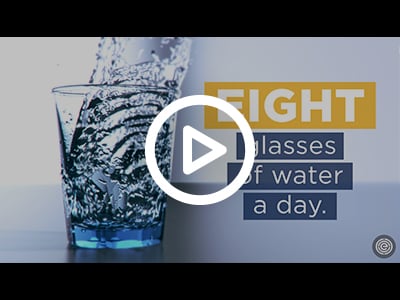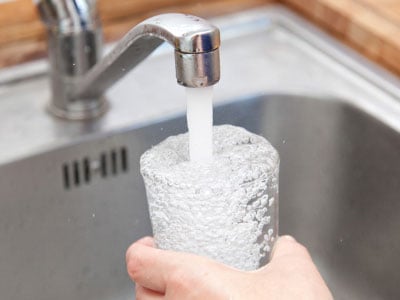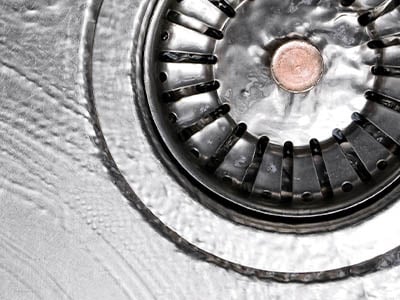City of Tucson
EWG's drinking water quality report shows results of tests conducted by the water utility and provided to the Environmental Working Group by the Arizona Department of Environmental Quality, as well as information from the U.S. EPA Enforcement and Compliance History database (ECHO). For the latest quarter assessed by the U.S. EPA (January 2021 - March 2021), tap water provided by this water utility was in compliance with federal health-based drinking water standards.
Utility Details
- Tucson, Arizona
- Serves: 675,686
- Data available: 2013-2020*
- Source: Groundwater
* 2013 testing is for chemicals in EPA's Third Unregulated Contaminant Monitoring Rule (UCMR-3) only. 2020/2021 testing is for chemicals in EPA's Fourth Unregulated Contaminant Monitoring Rule (UCMR-4) only.
Contaminants Detected
7
EXCEED
EWG HEALTH
GUIDELINES
25 Total Contaminants
- Legal does not necessarily equal safe. Getting a passing grade from the federal government does not mean the water meets the latest health guidelines.
- Legal limits for contaminants in tap water have not been updated in almost 20 years.
- The best way to ensure clean tap water is to keep pollution out of source water in the first place.
Looking for a countertop water filter?
Find out which filters earned EWG's recommendation
See the guideContaminants Detected
Arsenic
Potential Effect: cancer563x EWG'S HEALTH GUIDELINEArsenic
more aboutthis contaminant
Arsenic is a potent carcinogen and common contaminant in drinking water. Arsenic causes thousands of cases of cancer each year in the U.S. Click here to read more about arsenic.
Arsenic was found at 563 times above EWG's Health Guideline.
EWG Health Guideline
This Utility
Legal Limit
National Average
State Average
ppb = parts per billion
Health Risks
The EWG Health Guideline of 0.004 ppb for arsenic was defined by the California Office of Environmental Health Hazard Assessment as a public health goal, the level of a drinking water contaminant that does not pose a significant health risk. This health guideline protects against cancer.
Pollution Sources

Agriculture

Industry

Naturally Occurring
Filtering Options
Reverse Osmosis
Ion Exchange
Chromium (hexavalent)
Potential Effect: cancer32x EWG'S HEALTH GUIDELINEChromium (hexavalent)
more aboutthis contaminant
Chromium (hexavalent) is a carcinogen that commonly contaminates American drinking water. Chromium (hexavalent) in drinking water may be due to industrial pollution or natural occurrences in mineral deposits and groundwater. Read more about chromium (hexavalent).
Chromium (hexavalent) was found at 32 times above EWG's Health Guideline.
EWG Health Guideline
This Utility
National Average
State Average
ppb = parts per billion
Health Risks
The EWG Health Guideline of 0.02 ppb for chromium (hexavalent) was defined by the California Office of Environmental Health Hazard Assessment as a public health goal, the level of a drinking water contaminant that does not pose a significant health risk. This health guideline protects against cancer.
Pollution Sources

Industry

Naturally Occurring
Filtering Options
Reverse Osmosis
Ion Exchange
Haloacetic acids (HAA5)†
Potential Effect: cancer12x EWG'S HEALTH GUIDELINEHaloacetic acids (HAA5)
more aboutthis contaminant
Haloacetic acids are formed when disinfectants such as chlorine are added to tap water. The group of five haloacetic acids regulated by federal standards includes monochloroacetic acid, dichloroacetic acid, trichloroacetic acid, monobromoacetic acid and dibromoacetic acid.
Haloacetic acids (HAA5) was found at 12 times above EWG's Health Guideline.
EWG Health Guideline
This Utility
Legal Limit
National Average
State Average
ppb = parts per billion
Health Risks
The EWG Health Guideline of 0.1 ppb for the group of five haloacetic acids, or HAA5, was defined in a peer-reviewed scientific study by EWG and represents a one-in-a-million lifetime cancer risk level. This health guideline protects against cancer.
Pollution Sources
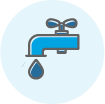
Treatment Byproducts
Filtering Options
Activated Carbon
Reverse Osmosis
Haloacetic acids (HAA9)†
Potential Effect: cancer65x EWG'S HEALTH GUIDELINEHaloacetic acids (HAA9)
more aboutthis contaminant
Haloacetic acids are formed when disinfectants such as chlorine are added to tap water. The group of nine haloacetic acids includes monochloroacetic acid, dichloroacetic acid, trichloroacetic acid, monobromoacetic acid and dibromoacetic acid, which are regulated as a group by the federal government (HAA5); and bromochloroacetic acid, bromodichloroacetic acid, chlorodibromoacetic acid, and tribromoacetic acid.
Haloacetic acids (HAA9) was found at 65 times above EWG's Health Guideline.
EWG Health Guideline
This Utility
National Average
State Average
ppb = parts per billion
Health Risks
The EWG Health Guideline of 0.06 ppb for the group of nine haloacetic acids, or HAA9, was defined in a peer-reviewed scientific study by EWG and represents a one-in-a-million lifetime cancer risk level as . This health guideline protects against cancer.
Pollution Sources

Treatment Byproducts
Filtering Options
Activated Carbon
Reverse Osmosis
Nitrate
Potential Effect: cancer13x EWG'S HEALTH GUIDELINENitrate
more aboutthis contaminant
Nitrate, a fertilizer chemical, frequently contaminates drinking water due to agricultural and urban runoff, and discharges from municipal wastewater treatment plants and septic tanks. Excessive nitrate in water can cause oxygen deprivation in infants and increase the risk of cancer. Click here to read more about nitrate.
Nitrate was found at 13 times above EWG's Health Guideline.
EWG Health Guideline
This Utility
Legal Limit
National Average
State Average
ppm = parts per million
Health Risks
The EWG Health Guideline of 0.14 ppm for nitrate was defined by EWG . This health guideline protects against cancer and harm to fetal growth and development.
Pollution Sources

Agriculture

Runoff & Sprawl

Naturally Occurring
Filtering Options
Reverse Osmosis
Ion Exchange
Total trihalomethanes (TTHMs)†
Potential Effect: cancer73x EWG'S HEALTH GUIDELINETotal trihalomethanes (TTHMs)
more aboutthis contaminant
Trihalomethanes are cancer-causing contaminants that form during water treatment with chlorine and other disinfectants. The total trihalomethanes group includes four chemicals: chloroform, bromodichloromethane, dibromochloromethane and bromoform.
Total trihalomethanes (TTHMs) was found at 73 times above EWG's Health Guideline.
EWG Health Guideline
This Utility
Legal Limit
National Average
State Average
ppb = parts per billion
Health Risks
The health guideline of 0.15 parts per billion, or ppb, for the group of four trihalomethanes, or THM4/TTHM, was defined in a peer-reviewed scientific study by EWG and represents a one-in-one-million lifetime cancer risk level.Pollution Sources

Treatment Byproducts
Filtering Options
Activated Carbon
Reverse Osmosis
Uranium
Potential Effect: cancer4.4x EWG'S HEALTH GUIDELINEUranium
more aboutthis contaminant
Uranium is a known human carcinogen. The federal legal limit for uranium is set at 30 micrograms per liter (corresponding to parts per billion), but utilities can also report uranium in picocuries per liter (pCi/L), which is a measure of radioactivity in water. EWG translated all uranium results to pCi/L using a conversion factor developed by the EPA. With this conversion approach, the limit of 30 ppb corresponds to 20 pCi/L. Drinking water with this much uranium would cause more than 4.6 cancer cases in a population of 100,000. California set a public health goal for uranium of 0.43 pCi/L.
Uranium was found at 4.4 times above EWG's Health Guideline.
EWG Health Guideline
This Utility
Legal Limit
National Average
State Average
pCi/L = picocuries per liter
Health Risks
The EWG Health Guideline of 0.43 pCi/L for uranium was defined by the California Office of Environmental Health Hazard Assessment as a public health goal, the level of a drinking water contaminant that does not pose a significant health risk. Three most common uranium isotopes are U-234, U-235 and U-238. All isotopes of uranium are radioactive, and the total radioactivity depends on the ratio of isotopes. This health guideline protects against cancer.
Pollution Sources

Industry

Naturally Occurring
Filtering Options
Reverse Osmosis
Ion Exchange
Includes chemicals detected in 2017-2019 for which annual utility averages exceeded an EWG-selected health guideline established by a federal or state public health authority; chemicals detected under the EPA's Unregulated Contaminant Monitoring Rule (UCMR 3) program in 2013 to 2015 (and subsequent testing when available), for which annual utility averages exceeded a health guideline established by a federal or state public health authority; chemicals detected under the EPA's Unregulated Contaminant Monitoring Rule (UCMR 4) program in 2017 to 2020 (and subsequent testing when available), for which annual utility averages exceeded a health guideline established by a federal or state public health authority; radiological contaminants detected between 2014 and 2019.
† HAA5 is a contaminant group that includes monochloroacetic acid, dichloroacetic acid, trichloroacetic acid, monobromoacetic acid and dibromoacetic acid. HAA9 is a contaminant group that includes the chemicals in HAA5 and bromochloroacetic acid, bromodichloroacetic acid, chlorodibromoacetic acid and tribromoacetic acid. TTHM is a contaminant group that includes bromodichloromethane, bromoform, chloroform and dibromochloromethane.
1,4-Dioxane
more aboutthis contaminant
1,4-Dioxane is a solvent classified by the EPA as a likely human carcinogen. It contaminates groundwater in many states due to industrial wastewater discharges, plastic manufacturing runoff and landfill runoff.
How your levels compare
EWG Health Guideline
This Utility
National Average
State Average
ppb = parts per billion
Health Risks
The EWG Health Guideline of 0.35 ppb for 1,4-dioxane was defined by the Environmental Protection Agency as a one-in-a-million lifetime risk of cancer. Values greater than one-in-a-million cancer risk level can result in increased cancer cases above one in a million people.
Pollution Sources

Industry

Runoff & Sprawl
Filtering Options
Reverse Osmosis
Atrazine
more aboutthis contaminant
Atrazine is a herbicide commonly detected in drinking water that comes from cornfield and other agricultural runoff. It is a hormone disrupter that harms the male and female reproductive systems of people and wildlife.
How your levels compare
EWG Health Guideline
This Utility
Legal Limit
National Average
State Average
ppb = parts per billion
Health Risks
The EWG Health Guideline of 0.1 ppb for atrazine was defined by EWG based on epidemiological studies of human exposure to atrazine in drinking water.. This health guideline protects against harm to the developing fetus, harm to the reproductive system and hormone disruption.
Pollution Sources

Agriculture
Filtering Options
Activated Carbon
Reverse Osmosis
Barium is a mineral present in rocks, soil and water. High concentrations of barium in drinking water increase the risk of cardiovascular disease and hypertension.
How your levels compare
EWG Health Guideline
This Utility
Legal Limit
National Average
State Average
ppb = parts per billion
Health Risks
The EWG Health Guideline of 700 ppb for barium was defined by EWG as benchmark that protects against harm to the kidneys and the cardiovascular system.
Pollution Sources

Industry

Naturally Occurring
Filtering Options
Reverse Osmosis
Ion Exchange
Chlorate
more aboutthis contaminant
Chlorate forms in drinking water as a byproduct of disinfection. Chlorate impairs thyroid function, making chlorate exposure most harmful during pregnancy and childhood.
How your levels compare
EWG Health Guideline
This Utility
National Average
State Average
ppb = parts per billion
Health Risks
The EWG Health Guideline of 210 ppb for chlorate was defined by the Environmental Protection Agency as a benchmark for testing under the Unregulated Contaminant Monitoring Rule program. This health guideline protects against hormone disruption.
Pollution Sources

Agriculture

Industry

Treatment Byproducts
Chlorodifluoromethane
more aboutthis contaminant
Chlorodifluoromethane (Freon 22) is a refrigerant, solvent and aerosol propellant banned in 2000 under the Montreal Protocol because of its ozone-depleting properties. Freons can cause heart, nervous system and liver damage.
How your levels compare
This Utility
National Average
State Average
ppb = parts per billion
Pollution Sources

Industry
Chromium (total)
more aboutthis contaminant
Chromium is a naturally occurring metal, but industrial uses can elevate its levels in water. One form, hexavalent chromium, causes cancer. Total chromium is not a good indicator of the amount of hexavalent chromium in drinking water.
How your levels compare
This Utility
Legal Limit
National Average
State Average
ppb = parts per billion
Pollution Sources

Industry

Naturally Occurring
Filtering Options
Reverse Osmosis
Ion Exchange
Di(2-ethylhexyl) phthalate
more aboutthis contaminant
Di(2-ethylhexyl) phthalate, or DEHP, is a softener added to PVC plastics. Phthalates are hormone disruptors that target the male reproductive system.
How your levels compare
EWG Health Guideline
This Utility
Legal Limit
National Average
State Average
ppb = parts per billion
Health Risks
The EWG Health Guideline of 3 ppb for di(2-ethylhexyl) phthalate was defined by the Environmental Protection Agency as a one-in-a-million lifetime risk of cancer. Values greater than one-in-a-million cancer risk level can result in increased cancer cases above one in a million people.
Pollution Sources

Industry

Runoff & Sprawl
Filtering Options
Activated Carbon
Reverse Osmosis
Fluoride
more aboutthis contaminant
Fluoride occurs naturally in surface and groundwater and is also added to drinking water by many water systems.
How your levels compare
This Utility
Legal Limit
National Average
State Average
ppm = parts per million
Pollution Sources

Treatment Byproducts
Filtering Options
Reverse Osmosis
Germanium
more aboutthis contaminant
Germanium is a naturally occuring element used as a component in semiconductors and fiber optics. Excessive exposures to germanium may harm the kidneys.
How your levels compare
This Utility
National Average
State Average
ppb = parts per billion
Pollution Sources

Naturally Occurring
Filtering Options
Reverse Osmosis
Manganese
more aboutthis contaminant
Manganese is a naturally occurring element that is common in food and drinking water. Excessive manganese exposures may impair children's attention, memory and intellectual capacity. Click here to read more about manganese.
How your levels compare
EWG Health Guideline
This Utility
National Average
State Average
ppb = parts per billion
Health Risks
The EWG Health Guideline of 100 ppb for manganese was defined by the state of Minnesota as a health risk limit, the concentration of a contaminant that can be consumed with little or no risk to health. This health guideline protects against harm to the brain and nervous system.
Pollution Sources

Industry

Naturally Occurring
Filtering Options
Ion Exchange
Molybdenum
more aboutthis contaminant
Molybdenum is a metal that occurs naturally in soil, minerals and water. People who ingest large amounts can have increased levels of uric acid and gout-like symptoms.
How your levels compare
EWG Health Guideline
This Utility
National Average
State Average
ppb = parts per billion
Health Risks
The EWG Health Guideline of 40 ppb for molybdenum was defined by the Environmental Protection Agency as a benchmark for testing under the Unregulated Contaminant Monitoring Rule program. This health guideline protects against metabolic changes and excess formation of uric acid in the blood.
Pollution Sources

Industry

Naturally Occurring
Filtering Options
Reverse Osmosis
Ion Exchange
o-toluidine
more aboutthis contaminant
The synthetic chemical o-toluidine is used to manufacture pesticides, dyes and other industrial chemicals. The International Agency for Research on Cancer has classified o-toluidine as carcinogenic to humans, and it may also harm the nervous system, kidneys and bladder.
How your levels compare
This Utility
National Average
State Average
ppb = parts per billion
Pollution Sources

Industry
Filtering Options
Activated Carbon
Reverse Osmosis
Pentachlorophenol
more aboutthis contaminant
Pentachlorophenol is a carcinogenic chemical used as a wood preservative. It harms developing fetuses, and causes immune suppression and hormone disruption.
How your levels compare
EWG Health Guideline
This Utility
Legal Limit
National Average
State Average
ppb = parts per billion
Health Risks
The EWG Health Guideline of 0.3 ppb for pentachlorophenol was defined by the California Office of Environmental Health Hazard Assessment as a public health goal, the level of a drinking water contaminant that does not pose a significant health risk. This health guideline protects against cancer.
Pollution Sources

Industry
Filtering Options
Activated Carbon
Reverse Osmosis
Radium, combined (-226 & -228)
Radium, combined (-226 & -228)
more aboutthis contaminant
Radium is a radioactive element that causes bone cancer and other cancers. It can occur naturally in groundwater, and oil and gas extraction activities such as hydraulic fracturing can elevate concentrations.
How your levels compare
EWG Health Guideline
This Utility
Legal Limit
National Average
State Average
pCi/L = picocuries per liter
Health Risks
EWG applied the health guideline of 0.05 pCi/L, defined by the California Office of Environmental Health Hazard Assessment as a public health goal for radium-226, to radium-226 and radium-228 combined. This health guideline protects against cancer.Pollution Sources

Industry

Naturally Occurring
Filtering Options
Reverse Osmosis
Ion Exchange
Selenium
more aboutthis contaminant
Selenium is an essential element in diets. But too much selenium can decrease thyroid hormone production and cause hair loss, skin lesions and brittle fingernails.
How your levels compare
EWG Health Guideline
This Utility
Legal Limit
National Average
State Average
ppb = parts per billion
Health Risks
The EWG Health Guideline of 30 ppb for selenium was defined by the California Office of Environmental Health Hazard Assessment as a public health goal, the level of a drinking water contaminant that does not pose a significant health risk. This health guideline protects against hair loss and nail damage.
Pollution Sources

Industry

Naturally Occurring
Filtering Options
Reverse Osmosis
Strontium
more aboutthis contaminant
Strontium is a metal that accumulates in the bones. Radioactive strontium-90 can cause bone cancer and leukemia, and any form of strontium at high doses can harm bone health.
How your levels compare
EWG Health Guideline
This Utility
National Average
State Average
ppb = parts per billion
Health Risks
The EWG Health Guideline of 1,500 ppb for strontium was defined by the Environmental Protection Agency as a benchmark for testing under the Unregulated Contaminant Monitoring Rule program. This health guideline protects against harm to bones.
Pollution Sources

Industry

Naturally Occurring
Filtering Options
Reverse Osmosis
Ion Exchange
Trichloroethylene
more aboutthis contaminant
Trichloroethylene, an industrial solvent and common groundwater pollutant, damages the immune system, harms the developing fetus and causes cancer.
How your levels compare
EWG Health Guideline
This Utility
Legal Limit
National Average
State Average
ppb = parts per billion
Health Risks
The EWG Health Guideline of 0.4 ppb for trichloroethylene was defined by the state of Minnesota as health risk limit, the concentration of a contaminant that can be consumed with little or no risk to health. This health guideline protects against harm to the developing fetus and damage to the immune system.
Pollution Sources

Industry
Filtering Options
Activated Carbon
Reverse Osmosis
Vanadium
more aboutthis contaminant
Vanadium is a metal used in steels and other alloys. People are commonly exposed to vanadium in water and food. Excessive exposure can be toxic during pregnancy and childhood.
How your levels compare
EWG Health Guideline
This Utility
National Average
State Average
ppb = parts per billion
Health Risks
The EWG Health Guideline of 21 ppb for vanadium was defined by the Environmental Protection Agency as a benchmark for testing under the Unregulated Contaminant Monitoring Rule program. This health guideline protects against change in blood chemistry.
Pollution Sources

Industry

Naturally Occurring
Filtering Options
Ion Exchange
Includes chemicals detected in 2017-2019 for which annual utility averages were lower than an EWG-selected health guideline established by a federal or state public health authority; chemicals detected under the EPA's Unregulated Contaminant Monitoring Rule (UCMR 3) program in 2013 to 2015 (and subsequent testing when available), for which annual utility averages were lower than an EWG-selected health guideline established by a federal or state public health authority; ; chemicals detected under the EPA's Unregulated Contaminant Monitoring Rule (UCMR 4) program in 2017 to 2020 (and subsequent testing when available), for which annual utility averages exceeded a health guideline established by a federal or state public health authori.
Other Contaminants Tested
✕City of Tucson compliance with legally mandated federal standards:
- From April 2019 to March 2021, City of Tucson complied with health-based drinking water standards.
- 3 QUARTERSin violation of any federal drinking water standard from April 2019 to March 2021
Information in this section on City of Tucson comes from the U.S. EPA Enforcement and Compliance History Online database (ECHO).
LEARN MORE ABOUT THIS UTILITYWater Filters That Can Reduce Contaminant Levels
| Contaminant | Activated Carbon | Reverse Osmosis | Ion Exchange |
| CONTAMINANTS ABOVE HEALTH GUIDELINES | |||
| Arsenic | ✔ | ✔ | |
| Chromium (hexavalent) | ✔ | ✔ | |
| Haloacetic acids (HAA5) | ✔ | ✔ | |
| Haloacetic acids (HAA9) | ✔ | ✔ | |
| Nitrate | ✔ | ✔ | |
| Total trihalomethanes (TTHMs) | ✔ | ✔ | |
| Uranium, combined (pCi/L) | ✔ | ✔ | |
| OTHER CONTAMINANTS DETECTED | |||
| 1,4-Dioxane | ✔ | ||
| Atrazine | ✔ | ✔ | |
| Barium | ✔ | ✔ | |
| Chlorate | |||
| Chlorodifluoromethane | |||
| Chromium (total) | ✔ | ✔ | |
| Di(2-ethylhexyl) phthalate | ✔ | ✔ | |
| Fluoride | ✔ | ||
| Germanium | ✔ | ||
| Manganese | ✔ | ||
| Molybdenum | ✔ | ✔ | |
| o-toluidine | ✔ | ✔ | |
| Pentachlorophenol | ✔ | ✔ | |
| Radium, combined (-226 & -228) | ✔ | ✔ | |
| Selenium | ✔ | ||
| Strontium | ✔ | ✔ | |
| Trichloroethylene | ✔ | ✔ | |
| Vanadium | ✔ | ||
Take Action
Contact Your Local Official
One of the best ways to push for cleaner water is to hold accountable the elected officials who have a say in water quality – from city hall and the state legislature to Congress all the way to the Oval Office – by asking questions and demanding answers.
LEARN MOREFilter Out Contaminants
Check out our recommendations for filters to protect your water against the detected contaminants.
EWG’S WATER FILTER GUIDE